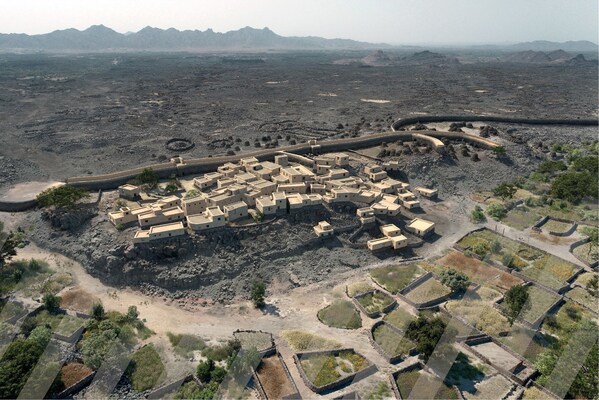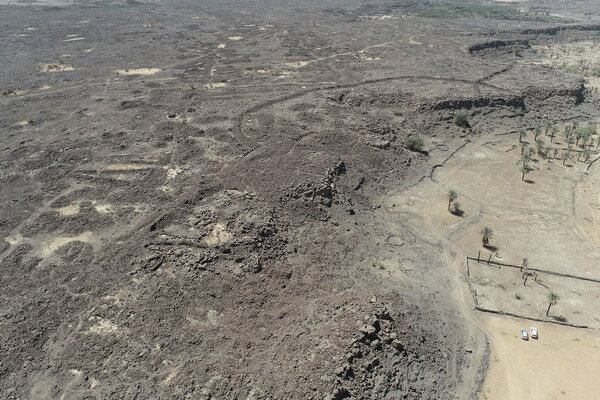 |
- Challenges traditional view of transition from nomadic pastoralism to nascent urbanism
ALULA, Saudi Arabia, Nov. 2, 2024 /PRNewswire/ -- New archaeological research has revealed an exceptional Bronze Age town in the Khaybar oasis of northwest Arabia, confirming a major transition from mobile, nomadic life to settled, town life in the second half of the third millennium BCE.
The finding infers that oases such as Khaybar were carefully controlled and valued landscapes that, with the advent of agriculture, supported permanent populations as centres for exchange and interaction with mobile communities. This nascent urbanism profoundly impacted the region's socio-economic organisation.

Fig. 14: A 3D virtual reconstruction of the Bronze Age town of al-Natah, based on newly published archaeological evidence. Khaybar LDAP (CNRS-AFALULA-RCU)
Known as al-Natah, the newly discovered town provides evidence for differentiated functional areas – residential and funerary – within fortifications. Al-Natah was built around 2400-2000 BCE and endured until 1500-1300 BCE. Home to some 500 people across 2.6 hectares, it was protected by a stone rampart that encircled the Khaybar oasis.
People in al-Natah lived in dwellings with the ground floor possibly used for storage, with living spaces above. They walked along narrow streets and buried their dead in stepped tower tombs. They prepared food with mortar and pestle, made and traded pottery, and travelled extensively. They worked metals, grew cereals, and raised animals.
His Highness Prince Badr bin Abdullah bin Mohammed bin Farhan Al Saud, Governor of the Royal Commission for AlUla and Minister of Culture for Saudi Arabia, stated: "This important archaeological discovery highlights the Kingdom's global significance in the field of archaeology and confirms the depth of civilisation that the land holds. This discovery reinforces the Kingdom's efforts in protecting cultural and historical heritage and emphasises the importance of exchanging knowledge and expertise with the world to enhance awareness of our shared human heritage."
His Highness added, "This discovery confirms the Kingdom's commitment to preserving the world's heritage and promoting cultural heritage in accordance with the provisions of Saudi Vision 2030. It also highlights the importance of strengthening international partnerships to present this rich legacy to future generations and the world."
The discovery was led by Dr Guillaume Charloux of the Khaybar Longue Durée Archaeological Project and the French National Centre for Scientific Research (CNRS), and includes Saudis from the Royal Commission for AlUla (RCU), Dr Munirah Almushawh, a co-director of the project, and Saifi Alshilali, a historian and a member of the local community in Khaybar.
The research was sponsored by the RCU and the French Agency for the Development of AlUla (AFALULA). RCU's Archaeology, Collections and Conservation team is directing an ambitious archaeological research programme in AlUla.
The discovery furthers the emergence of AlUla and Saudi Arabia as global centres for archaeological research and intercultural dialogue. By commissioning and championing revelatory research on past human activity, RCU is demonstrating its archaeological leadership and responsible custodianship of cultural heritage.
Published in the peer-reviewed journal PLOS One, the research challenges the picture of mobile pastoral-nomadism as the dominant economic and social way of life of northwest Arabia in the Early and Middle Bronze Ages.
Dr Charloux, stated: "Our discovery challenges the model of northwest Arabia in the Bronze Age. Al-Natah confirms that rural urbanism arose earlier than believed, making it possible to consider the complexity of a sedentary settlement in a walled Bronze Age oasis."
During the coming autumn fieldwork season, RCU is supporting 10 archaeological projects comprising more than 100 archaeologists and associated specialists in AlUla County and Khaybar.
The article can be found here: https://journals.plos.org/plosone/article?id=10.1371/journal.pone.0309963
For an image gallery and captions, including a rendering of what al-Natah might have looked like, visit: https://drive.google.com/drive/folders/1_Jbw6gbmTHGG27DGtdyMcVwxc-M8y_k4
source: The Royal Commission for AlUla (RCU)
【你點睇】港鐵失倫敦伊利沙伯線專營權,你認為「國際化」遇挫的港鐵應否將重心轉移回本地?► 立即投票
































